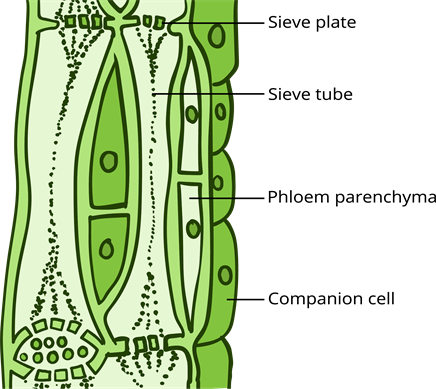PDF chapter test TRY NOW
Phloem
The term Phloem was introduced by C. Nageli (1858). The word "phloem" is extracted from the Greek, meaning "bark". Phloem is the other complex tissue system in the plants. It is the food conducting tissues of the vascular plant. The materials (food), i.e. (towards the root and stem) can move in both directions because phloem transports food and water from leaves to all plant parts. All phloem cells are living except phloem fibres. The phloem is heterogeneous (complex tissues). It is a permanent tissue composed of different types of elements: Sieve elements, Companion cells, Phloem fibres and Phloem parenchyma.


Phloem cells
Sieve elements:
- These are the channels of conduction of food materials in phloem.
- Sieve elements are of two types; namely, a sieve cells and sieve tubes.
- They are the living elements in the phloem with protoplasm.
- The lignified secondary cell wall is absent in sieve elements.
Sieve tubes:
- They are predominantly found in angiosperms.
- Sieve tubes are with primary cell wall only.
- They do not contain lignin on their wall.
- These are long, tubular cells with perforated walls (small pores in the wall).
- Sieve tubes are an advanced type of conducting structures in phloem.
Sieve cells:
- These are the primitive types of conducting elements in the phloem found in pteridophytes (pteridophytes produce neither flowers nor seeds: It is reproduced and disperse via spores) and gymnosperms (Non-flowering plants).
- These are long, conducting cells in the phloem that do not form sieve tubes.
The significant difference between sieve cells and sieve-tube members is the lack of sieve plates in sieve cells.
Companion cells:
- The companion cells are only found in angiosperms.
- These are specialised type of parenchyma cells present in phloem tissue.
- These are small elongated cells with thin cell walls with only a primary cell wall, which is not perforated, and it is a living parenchymatous cells with protoplasm.
- Companion cell and sieve tubes function together for the translocation of food.
- The sieve tubes and companion cells are sister cells because it is originated from the same mother cell.
Phloem parenchyma:
- Parenchyma present in phloem is called phloem parenchyma. It occurs in both primary and secondary phloem. These are present in dicot roots, leaves, and stems but are absent in monocot plants.
- These are thin-walled cells filled with protoplasm and nucleus, which helps store starch and slow sideways conduction of food.
- It helps to transport organic nutrients from the leaves to the parts of the plant body.
Phloem fibres:
- These are thick-walled (due to the lignification in secondary cell wall) sclerenchyma (dead) cells which provide mechanical strength to the tissue.
- It is also called Bast fibre or skin fibre.
Reference:
https://commons.wikimedia.org/wiki/File:Phloem_cells.svg
